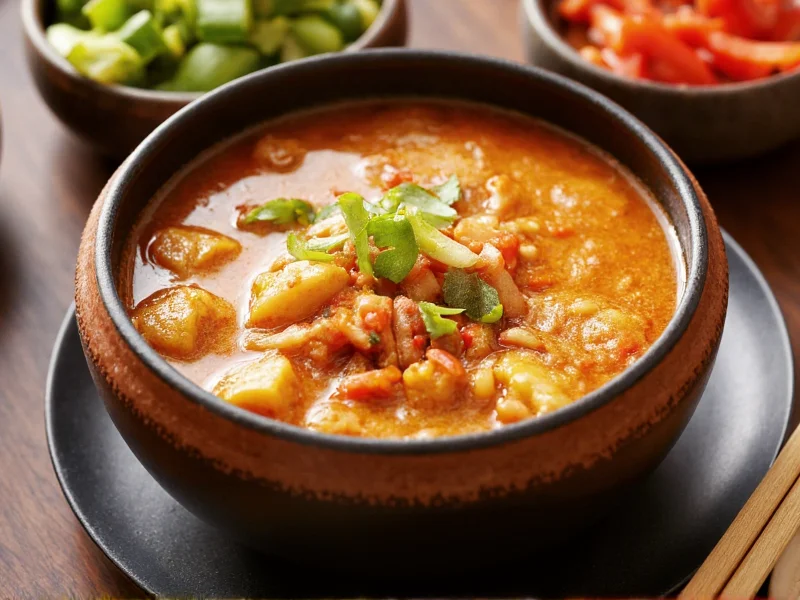For centuries, this iconic Chinese culinary creation has delighted palates with its complex interplay of contrasting flavors. Unlike many Western interpretations that rely heavily on chili oil, authentic hot and sour soup achieves its distinctive character through carefully balanced ingredients that create both warming heat and refreshing sourness without overwhelming either sensation.
Historical Origins and Cultural Significance
Tracing back to China's Sichuan province during the Tang Dynasty (618-907 AD), hot and sour soup emerged from the region's culinary tradition of balancing bold flavors. Sichuan cuisine, renowned for its mala (numbing-spicy) profile, developed this soup as a digestive aid and warming dish during cold, damp winters. The original preparation used locally available ingredients like wood ear mushrooms, cloud ear fungus, and Sichuan peppercorns, creating a broth that was both medicinal and deeply satisfying.
As Chinese culinary traditions spread globally, hot and sour soup became one of the most recognizable dishes in Chinese-American cuisine, though often significantly adapted. Traditional versions maintain a delicate equilibrium where neither the "hot" nor "sour" dominates, creating a harmonious flavor profile that stimulates the appetite while providing comfort.
Authentic Ingredients and Their Roles
The magic of genuine hot and sour soup lies in its specific ingredient composition and preparation technique. Unlike simplified Western versions, authentic recipes rely on precise combinations:
| Essential Ingredient | Traditional Purpose | Western Adaptation Issue |
|---|---|---|
| Chinkiang vinegar | Provides complex sourness with subtle sweetness | Often substituted with rice vinegar, lacking depth |
| White pepper | Creates warming heat without burning sensation | Frequently replaced with chili oil, altering flavor profile |
| Wood ear mushrooms | Contributes earthy notes and distinctive texture | Sometimes omitted or replaced with button mushrooms |
| Bamboo shoots | Adds subtle sweetness and crunch | Often overcooked, losing texture |
| Egg threads | Creates silky texture and visual appeal | Improperly added, becoming scrambled eggs |
Regional Variations Across China
While Sichuan version remains the most famous, regional interpretations showcase China's culinary diversity:
- Sichuan style: Features pronounced heat from white pepper with moderate sourness, often includes shredded pork, and uses a thicker broth achieved through traditional cornstarch slurry techniques
- Cantonese adaptation: More delicate balance with emphasis on sourness over heat, frequently incorporates seafood like shrimp or scallops, and maintains a lighter broth consistency
- Northern Chinese version: Incorporates more vinegar for pronounced sourness with milder heat, often includes shredded chicken, and sometimes features a touch of sweetness
Understanding these regional differences helps explain why authentic hot and sour soup preparation varies significantly from the standardized versions found in many Western Chinese restaurants.
Common Misconceptions in Western Preparations
Many restaurant versions outside Asia commit critical errors that alter the soup's fundamental character. The most frequent mistake involves substituting chili oil for white pepper, creating a fundamentally different flavor profile that emphasizes capsaicin heat rather than the warming sensation of white pepper. Another common issue is improper thickening—authentic versions use a light cornstarch slurry that enhances mouthfeel without creating a gelatinous texture.
Traditional preparation requires careful timing: vinegar added near the end preserves its bright acidity, while white pepper benefits from brief simmering to release its aromatic compounds. Egg incorporation follows a specific technique where beaten egg is slowly drizzled into the gently simmering broth to create delicate threads rather than scrambled chunks.
Nutritional Profile and Health Benefits
When prepared traditionally, hot and sour soup offers notable nutritional advantages. The mushroom varieties provide selenium and B vitamins, while bamboo shoots contribute dietary fiber. The vinegar component aids digestion, and the warming properties of white pepper can help stimulate circulation.
A standard serving (about 1 cup) of authentic preparation typically contains:
- 80-120 calories
- 3-5 grams of protein
- 2-4 grams of dietary fiber
- Significant vitamin B complex from mushrooms
- Negligible saturated fat in vegetarian versions
Unlike many restaurant versions loaded with sodium, traditional preparation maintains moderate salt levels, allowing the natural flavors of ingredients to shine through. For those seeking vegan hot and sour soup adaptation, simply omitting meat products while maintaining the essential mushroom and vegetable components creates an equally satisfying dish.
Preparing Authentic Hot and Sour Soup at Home
Creating an authentic version requires attention to technique rather than exotic ingredients. Start with a quality chicken or vegetable broth as your base, bringing it to a gentle simmer. Add prepared ingredients in sequence—first the harder vegetables like bamboo shoots, followed by mushrooms, then the flavoring elements. The critical moment comes when incorporating the vinegar and white pepper: these should be added toward the end of cooking to preserve their distinctive characteristics.
The traditional thickening method involves creating a cornstarch slurry (cornstarch mixed with cold water) and gradually incorporating it into the simmering broth while stirring constantly. The soup should achieve a consistency that coats the back of a spoon lightly—not too thin like broth, not too thick like gravy. Finally, the egg threads are created by slowly drizzling beaten egg into the gently simmering soup while stirring in one direction.
Cultural Context and Serving Traditions
In Chinese culinary tradition, hot and sour soup serves specific purposes beyond mere taste. It frequently appears as the opening course in multi-dish meals to stimulate the appetite, or as a restorative dish when someone feels under the weather. The warming properties make it particularly popular during colder months, while the vinegar component provides a refreshing counterpoint during warmer seasons.
Understanding the difference between hot and sour soup and wonton soup reveals important distinctions in Chinese culinary philosophy—while wonton soup emphasizes the dumpling as the star with broth as supporting element, hot and sour soup celebrates the broth itself as the primary culinary achievement, with ingredients serving to enhance rather than dominate the liquid foundation.











 浙公网安备
33010002000092号
浙公网安备
33010002000092号 浙B2-20120091-4
浙B2-20120091-4